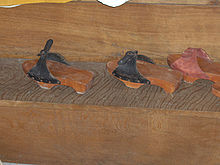The earliest known shoes are sandals dating from approximately 7,000 or 8,000 B.C., found in theFort Rock Cave in the US state of Oregon. in 1938.[1] The world's oldest leather shoe, made from a single piece of cowhide laced with a leather cord along seams at the front and back, was found in a cave in Armenia in 2008 and is believed to date to 3,500 B.C.[2][3] Ötzi the Iceman's shoes, dating to 3,300 BC, featured brown bearskin bases, deerskin side panels, and a bark-string net, which pulled tight around the foot.[2] However, it is estimated that shoes may have been used long before this, but it is difficult to find evidence of the earliest footwear due to the highly perishable nature of early shoes.[4] By studying the bones of the smaller toes (as opposed to the big toe), it was observed that their thickness decreased approximately 40,000 to 26,000 years ago. This led archaeologists to deduce that wearing shoes resulted in less bone growth, resulting in shorter, thinner toes.[5] These earliest designs were very simple in design, often mere "foot bags" of leather to protect the feet from rocks, debris, and cold. They were more commonly found in colder climates.
Many early natives in North America wore a similar type of footwear known as the moccasin. These are tight-fitting, soft-soled shoes typically made out of leather or bison hides. Many moccasins were also decorated with various beads and other adornments. Moccasins were not designed to get wet, and in wet weather and warm summer months, most Native Americans went barefoot.[6]
As civilizations began to develop, thong sandals (the precursors of the modern flip-flop) were worn. This practice dates back to pictures of them in ancient Egyptian murals from 4,000 B.C. One pair found in Europe was made of papyrus leaves and dated to be approximately 1,500 years old. They were also worn in Jerusalem during the time of Jesus Christ.[7] Thong sandals were worn by many civilizations and made from a wide variety of materials. Ancient Egyptian sandals were made from papyrus and palm leaves. The Masai of Africa made them out of rawhide. In India, they were made from wood. In China and Japan, rice straw was used. The leaves of the sisal plant were used to make twine for sandals in South America, while the natives of Mexico used the Yucca plant.[8][9]
While thong sandals were commonly worn, many people in ancient times, such as the Egyptians, Hindu and Greeks, saw little need for footwear, and most of the time, preferred being barefoot. The Egyptians and Hindus made some use of ornamental footwear, such as a soleless sandal known as a "Cleopatra", which did not provide any practical protection for the foot. The ancient Greeks largely viewed footwear as self-indulgent, unaesthetic and unnecessary. Shoes were primarily worn in the theater, as a means of increasing stature, and many preferred to go barefoot.[10] Athletes in the Ancient Olympic Games participated barefoot – and naked.[11] Even the gods and heroes were primarily depicted barefoot, and the hoplite warriors fought battles in bare feet and Alexander the Great conquered his vast empire with barefoot armies. The runners of Ancient Greece are also believed to have run barefoot. Pheidippides, the first marathoner, ran from Athens to Sparta in less than 36 hours.[12] After the Battle of Marathon, he ran straight from the battlefield to Athens to inform the Athenians of the news.[13]
The Romans, who eventually conquered the Greeks, and adopted many aspects of their culture, did not adopt the Greek perception of footwear and clothing. Roman clothing was seen as a sign of power, and footwear was seen as a necessity of living in a civilized world, although the slaves and paupers usually went barefoot.[10] There are many references to shoes being worn in the Bible. During weddings of this period, a father would give his son-in-law a pair of shoes, to symbolize the transfer of authority.[14] Slaves were also commonly barefoot, and shoes were considered badges of freedom since biblical times:
But the father said to his servants, Bring forth the best robe, and put [it] on him; and put a ring on his hand, and shoes on [his] feet (Luke 15:22).
A common casual shoe in the Pyrenees during the Middle Ages are espadrilles. These are sandals with braided jute soles and a fabric upper portion, and often includes fabric laces that tie around the ankle. The term is French and comes from the esparto grass. The shoes originate in the Catalonian region of Spain as early as the 13th century, and were commonly worn by peasants in the farming communities in the area.[9]
By the 15th Century, pattens became popular by both men and women in Europe. These are commonly seen as the predecessor of the modern high-heeled shoe,[15] while the poor and lower classes in Europe, as well as slaves in the New World, were barefoot.[10] In the 15th century, the Crakow was fashionable in Europe. This style of shoe is named because it is thought to have originated in Kraków, the capitol of Poland. The style is characterized by the point of the shoe, known as the "polaine", which often was supported by a whalebone tied to the knee to prevent the point getting in the way while walking.[16] Also during the 15th century, chopines were created in Turkey, and were usually 7-8 inches (17.7-20.3 cm) high. These shoes became popular in Venice and throughout Europe, as a status symbolrevealing wealth and social standing. During the 16th century, royalty started wearing high-heeled shoes to make them look taller or larger than life, such as Catherine de Medici orMary I of England. By 1580, even men wore them, and a person with authority or wealth was often referred to as, "well-heeled".[15]
Many medieval shoes were made using the turnshoe method of construction, in which the upper was turned flesh side out, and was lasted onto the sole and joined to the edge by a seam. The shoe was then turned inside-out so that the grain was outside. Some shoes were developed with toggled flaps or drawstrings to tighten the leather around the foot for a better fit. The turnshoe method was replaced by the welted method around 1500.[17]
Eventually the modern shoe, with a sewn-on sole, was devised. Since the 17th century, most leather shoes have used a sewn-on sole. This remains the standard for finer-quality dress shoes today. Until around 1800, shoes were made without differentiation for the left or right foot. Such shoes are now referred to as "straights".[18] Only gradually did the modern foot-specific shoe become standard.
Since the mid-20th Century, advances in rubber, plastics, synthetic cloth, and industrial adhesives have allowed manufacturers to create shoes that stray considerably from traditional crafting techniques. Leather, which had been the primary material in earlier styles, has remained standard in expensive dress shoes, but athletic shoes often have little or no real leather. Soles, which were once laboriously hand-stitched on, are now more often machine stitched or simply glued on. Many of these newer materials, such as rubber and plastics, have made shoes less biodegradable. It is estimated that most mass-produced shoes require 1000 years to degrade in alandfill.[19] In the late 2000s, some shoemakers picked up on the issue and began to produce shoes made entirely from degradable materials, such as the Nike Considered.[20][21]
In 2007, the global shoe industry had an overall market of $107.4 billion, in terms of revenue, and is expected to grow to $122.9 billion by the end of 2012. Shoe manufacturers in the People's Republic of China account for 63% of production, 40.5% of global exports and 55% of industry revenue. However, many manufacturers in Europe dominate the higher-priced, higher value-added end of the market.[22]
Culture and folklore
As an integral part of human culture and civilization, shoes have found their way into our culture, folklore, and art. A popular 18th century nursery rhyme is There was an Old Woman Who Lived in a Shoe. This story tells about an old woman living in a shoe with a lot of children. In 1948, Mahlon Haines, a shoe salesman in Hallam, Pennsylvania, built an actual house shaped like a work boot as a form of advertisement. The Haines Shoe House was rented to newlyweds and the elderly until his death in 1962. Since then, it has served as anice cream parlor, a bed and breakfast, and a museum. It still stands today and is a popular roadside attraction.[23]
Shoes also play an important role in the fairy tales Cinderella and The Red Shoes. In thechildren's book and movie, The Wonderful Wizard of Oz, a pair of red ruby slippers play a key role in the plot. The 1985 comedy The Man with One Red Shoe features an eccentric man wearing one normal business shoe and one red shoe that becomes central to the plot.
Athletic sneaker collection has also existed as a part of urban subculture in the United States for several decades.[24] Recent decades have seen this trend spread to European nations such as the Czech Republic.[25] A Sneakerhead is a person who owns multiple pairs of shoes as a form of collection and fashion. A contributor to the growth of sneaker collecting is the continued worldwide popularity of the Air Jordan line of sneakers designed by Nike for Basketball star Michael Jordan.
In the Holy Bible's Old Testament, the shoe is used to symbolize something that is worthless or of little value. In the New Testament, the act of removing one's shoes symbolizes servitude. The Semites regarded the act of removing their shoes as a mark of reverence when approaching a sacred person or place.[26] In the Book of Exodus, Moses was instructed to remove his shoes before approaching the burning bush:
Put off thy shoes from off thy feet, for the place whereon thou standest [is] holy ground (Exodus 3:5).
The removal of the shoe also symbolizes the act of giving up a legal right. In Hebrew custom, the widow removed the shoe of her late husband's brother to symbolize that he had abandoned his duty. In arab custom, the removal of one's shoe also symbolized the dissolution of marriage.[26]
In Arab culture, showing the sole of your shoe is considered an insult, and to throw your shoe and hit someone with it, is considered an even greater insult. This is because the shoe is considered dirty because it touches the ground and is associated with the lowest part of the body — the foot. As such, shoes are forbidden in mosques, and it is also considered rude to cross your legs and display your soles to someone when talking to them. This insult was demonstrated in Iraq, first when Saddam Hussein's statue was toppled in 2003, Iraqis gathered around it and struck the statue with their shoes.[27] Secondly, in 2008, United States President George W. Bush had a shoe thrown at him by a journalism as a statement against the war that was brought to Iraq and the lives that it has cost.[28]
Empty shoes may also symbolize death. In Greek culture, empty shoes are the equivalent of the American funeral wreath. For example, empty shoes placed outside of a Greek home would tell others that the family's son has died in battle.[29] At an observation memorializing the 10th anniversary of the September 11 attacks, 3,000 pairs of empty shoes were used to recognize those killed.[30]




No comments:
Post a Comment